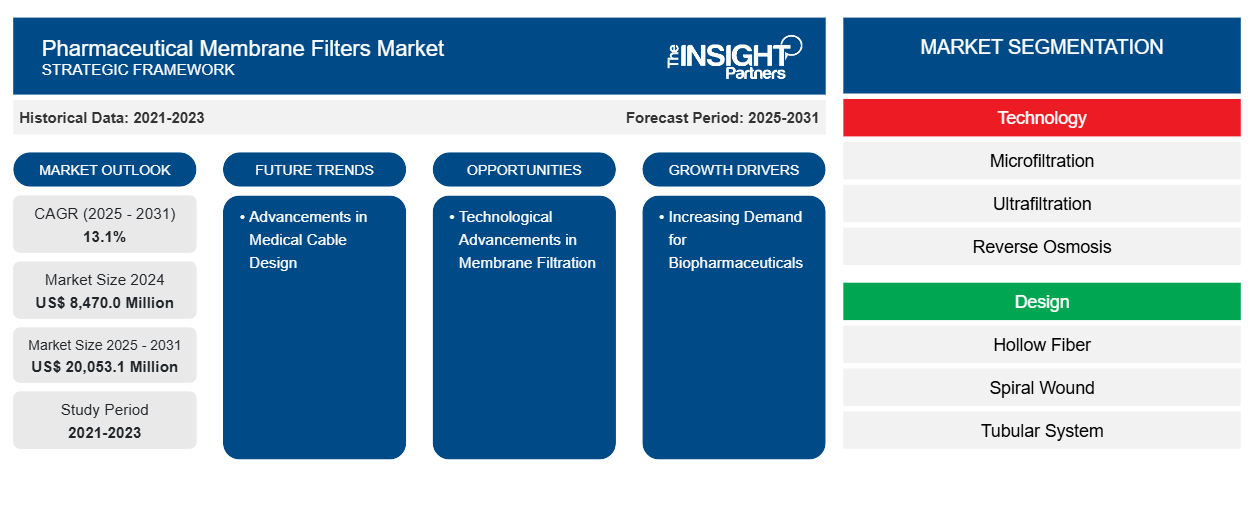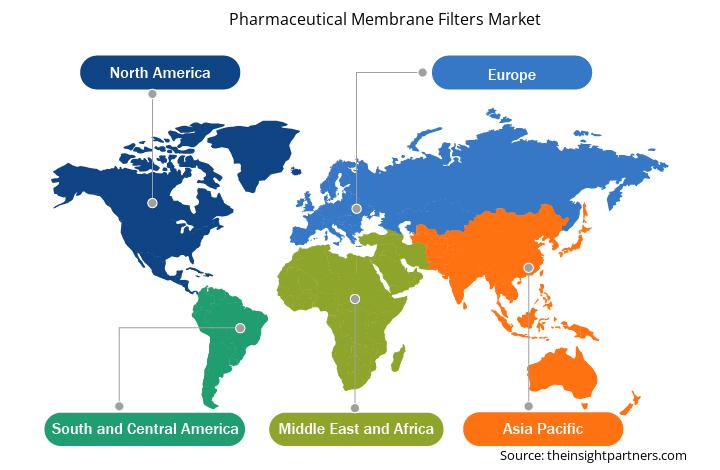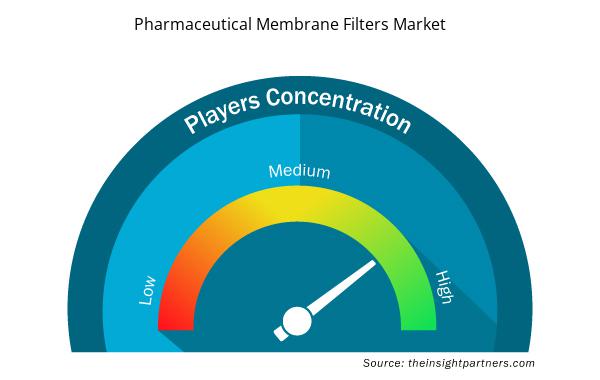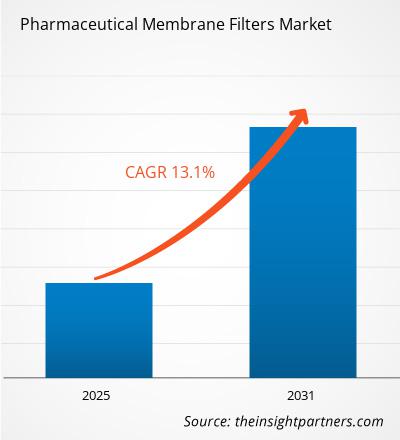预计到2031年,药用膜过滤器市场规模将从2024年的84.7亿美元增至200.531亿美元。预计2025-2031年期间,该市场的复合年增长率将达到13.1%。医用电缆设计的进步可能会在未来几年为药用膜过滤器市场带来新的趋势。
药用膜过滤器市场分析
推动制药膜过滤器市场发展的因素包括生物制药需求的不断增长以及严格的监管要求和质量保证。此外,膜过滤技术的进步预计将为市场创造未来的增长机会。
药用膜过滤器市场概况
预计北美将主导药用膜过滤器市场,而亚太地区预计将实现显著增长,这得益于医疗基础设施的快速扩张、药品产量的不断增长、生物制剂应用的不断增加以及相关支持性法规的出台。中国和印度在制造业方面处于领先地位,日本和韩国专注于创新,而澳大利亚的生物技术投资不断增长,这些因素共同推动了市场扩张。同样,欧洲市场也正经历着强劲增长。严格的欧盟法规、生物制剂应用的不断增加以及制药制造业的蓬勃发展推动了需求增长。德国在创新方面处于领先地位,英国和法国拥有强大的研发实力,而意大利和西班牙则扩大了生产规模,这些因素共同推动了市场扩张。
定制此报告以满足您的要求
您可以免费定制任何报告,包括本报告的部分内容、国家级分析、Excel 数据包,以及为初创企业和大学提供优惠和折扣
药用膜过滤器市场:

- 获取此报告的顶级关键市场趋势。此免费样品将包括数据分析,从市场趋势到估计和预测。
药用膜过滤器市场驱动因素和机遇
严格的监管要求和质量保证有利于市场增长
严格的监管要求以及药品生产过程中对质量保证的日益重视推动了制药膜过滤器市场的增长。美国食品药品监督管理局 (FDA) 和欧洲药品管理局 (EMA) 等监管机构对无菌过滤制定了严格的指导方针,以确保药品的安全性和有效性。同时,遵守良好生产规范 (GMP) 要求采用高质量的过滤系统以防止污染。USP 797 & 800 以及 ISO 14644 等标准强化了制药公司在无菌药物生产中使用先进膜过滤器的必要性。质量保证起着至关重要的作用,因为膜过滤器对于无菌和污染控制至关重要,尤其是在注射剂、疫苗和生物制剂领域,这些领域必须进行严格的过滤器完整性测试(例如,起泡点测试、扩散测试和压力保持测试),以符合法规要求。该行业对一次性过滤系统的需求日益增长,该系统可以加强质量控制并最大限度地降低交叉污染风险,尤其是在生物制药生产中。基因治疗和个性化医疗的应用正在增加,这需要先进的膜过滤技术。例如,截至 2024 年 3 月,美国 FDA 批准了 36 种基因疗法,另外还有 500 种疗法正在研发中。美国国家经济研究局预测,到 2034 年底,美国将有超过 100 万患者接受基因治疗,每年的费用将超过 250 亿美元。FDA 预计到 2025 年每年将批准 10-20 种新的基因疗法。合同开发和制造组织 (CDMO) 的扩张推动了对高性能过滤解决方案的需求,而纳滤和超滤技术的不断进步正在扩大市场机会。随着制药商努力满足不断变化的全球法规并确保最高质量标准,对高性能膜过滤器的需求预计将大幅增长。因此,制药公司正在积极加强其合规性和质量保证体系,以满足这些严格的标准。例如,住友制药强调遵守各种准则,包括良好实验室规范 (GLP)、良好临床规范 (GCP) 和良好生产规范 (GMP),并通过审核研发和上市后活动中的工作程序来确保可靠性。同样,阿斯利康也制定了全面的全球政策,概述了最高级别的要求,以支持药品研发、生产和分销过程中的产品质量和合规性。
膜过滤技术进步为市场增长带来充足机会
膜过滤领域正在快速发展,突破性的创新为制药、生物技术、食品饮料以及水处理等行业创造了新的机遇。各公司正在不断突破效率、耐用性和自动化的界限,以满足市场需求。无论是改进药品生产、确保饮用水安全,还是优化食品加工,纳米纤维膜、智能过滤系统和自动化等最新技术进步都在改变着行业格局。投资研发下一代过滤技术的制造商,将在这个以前所未有的速度扩张的市场中占据领先地位。
该领域的突破之一是纳米纤维膜技术。传统的过滤系统常常面临堵塞、寿命缩短和性能不稳定等问题。纳米纤维膜通过提供更大的表面积解决了这些问题,从而实现了更高的过滤效率和更持久的性能。纳米纤维膜增强的机械强度和耐化学性使其成为工业应用的理想选择,尤其是在对纯度和无菌性要求严格的制药行业。随着药品制造、疫苗生产和生物加工对高容量过滤需求的不断增长,这些先进的膜提供了一种可扩展且经济高效的解决方案,可提高效率并减少维护问题。
智能过滤系统正在改变各行各业监控和管理过滤过程的方式。通过集成物联网 (IoT),制造商在过滤装置中嵌入传感器,实时监测压力水平、过滤器健康状况和潜在堵塞情况。这些系统能够检测并预测问题,使企业能够在故障发生前进行维护。这种预测技术对制药和生物技术公司尤其重要,因为在这些公司中,保持精确的过滤标准对于安全、合规和效率至关重要。随着各行各业走向数字化,对物联网过滤系统的需求激增,这使其成为一个巨大的市场机遇。另一个颠覆性技术是自动化过滤。传统上,过滤系统需要持续的人工监控,这导致成本增加和出错风险。现在,自清洁机制、自动反冲洗和自适应过程控制正在使过滤系统更加可靠和高效。食品饮料等行业正在迅速将这些自动化解决方案应用于乳制品加工、果汁澄清和水净化。自动化能够减少水和能源的消耗,同时确保产品质量始终如一,这对于希望削减成本和提高可持续性的公司来说是一项有吸引力的投资。
对于制药商来说,这些进步来得正是时候。该行业正在快速扩张,尤其是在生物制剂和疫苗生产领域,高通量过滤至关重要。传统方法往往难以实现规模化,但纳米纤维膜和智能过滤等现代解决方案能够在不牺牲质量的情况下实现更高效的处理。此外,美国食品药品监督管理局 (FDA) 和欧洲药品管理局 (EMA) 等机构制定的严格监管标准要求企业投资顶级过滤技术,以保持合规性并避免昂贵的生产成本。水和废水处理行业将从先进的膜过滤技术中受益匪浅。随着全球对水资源短缺和污染问题的日益担忧,各行各业和市政当局正在积极寻求有效的净化技术。纳米纤维膜已被证明在去除细菌、病毒和微污染物方面非常有效,使其适用于海水淡化、废水回收和饮用水生产。智能传感器的集成进一步提高了效率,优化了化学品的使用和过滤周期,从而降低了运营成本。
投资下一代膜过滤的研发被视为获得竞争优势的制胜策略。在该领域进行创新的公司将满足日益增长的精密过滤需求,并在这个正朝着自动化、数字化和可持续发展方向发展的行业中占据领先地位。主要参与者正在建立战略合作伙伴关系,探索先进材料,并集成人工智能驱动的监控系统,以拓展业务。例如,
- 2025年,Cleanova 收购了总部位于英国、以高品质液体过滤系统闻名的 Allied Filter Systems Ltd,进一步拓展了其产品组合。此举符合 Cleanova 开拓先进过滤解决方案的战略,并强化了其以客户为中心的创新承诺。
- 2024年,ABB收购了加拿大光学传感器技术供应商Real Tech,增强了其在智能水管理方面的能力。此次收购实现了实时水质监测和测试,将先进的传感器技术整合到ABB的产品组合中。
- 2024年,唐纳森公司收购了意大利医疗过滤解决方案公司Medica SpA 49%的股份。此项投资支持唐纳森拓展生命科学领域并利用Medica在先进过滤材料方面专业知识的战略。
通过采用纳米纤维技术、物联网驱动的智能系统和自动化技术,制造商正在使过滤更加高效、可靠且经济高效。重视过滤技术创新的公司有望在市场份额中占据主导地位。该领域的关键发展包括:
- Elmarco 开发了 Nanospider,这是一款工业规模的设备,是生产纯纳米纤维 HEPA 级过滤介质的关键。这项技术在推进高效空气过滤应用方面发挥了重要作用。
- 纳米纤维研发公司RESPILON推出了独特的纳米纤维生产技术NUENEX。这项创新技术将现有药物转化为一种革命性的隐形贴片式个人给药系统,展现了纳米纤维应用的多功能性。
- 总部位于土耳其的 HiFyber 公司推出了一种新型多层、全合成、节能且可折叠的纳米纤维滤材。这一创新技术满足了市场对低能耗过滤器的需求,解决了经济和环境问题。
药用膜过滤器市场报告细分分析
有助于药用膜过滤器市场分析的关键部分是材料、技术、设计和最终用户。
- 根据材料,药用膜过滤器可分为聚醚砜 (PES)、聚砜 (PS)、纤维素基、聚四氟乙烯 (PTFE)、聚氯乙烯 (PVC)、聚丙烯腈 (PAN) 和其他。聚醚砜在 2024 年占据了最大的市场份额,预计在 2024 年至 2031 年期间将实现更高的复合年增长率。
- 根据设计,药用膜过滤器市场细分为卷绕式、管式、中空纤维式、板框式。中空纤维式过滤器在2024年占据了最大的市场份额,预计在2024年至2031年期间将实现最高的复合年增长率。
- 根据最终用户,医药膜过滤器市场细分为制药和生物技术行业以及合同研究组织 (CRO) 和合同开发生产组织 (CDMO)。制药和生物技术行业在2024年占据市场主导地位,预计在2024年至2031年期间将实现更高的复合年增长率。
- 从技术角度来看,医疗注塑市场细分为反渗透、微滤、超滤和纳滤。微滤领域在2024年占据市场主导地位,而纳滤领域预计在2024-2031年期间将实现最高的复合年增长率。
药用膜过滤器市场份额(按地区)分析
制药膜过滤器市场报告的地理范围主要分为五个区域:北美、亚太、欧洲、中东和非洲以及南美和中美。
2023年,北美占据了相当大的市场份额,这得益于强劲的生物制药行业、严格的监管标准以及对无菌药品制造日益增长的需求。生物加工领域投资的不断增加、一次性过滤技术的采用以及精准医疗的进步,进一步巩固了该地区的主导地位。根据行业报告,北美占据了全球制药过滤市场35%以上的份额,其中美国凭借其关键参与者和强大的研发生态系统占据领先地位。此外,慢性病患病率的不断上升和疫苗产量的不断扩大也加速了该地区市场的增长。
药用膜过滤器市场区域洞察
Insight Partners 的分析师已详尽阐述了预测期内影响制药膜过滤器市场的区域趋势和因素。本节还讨论了北美、欧洲、亚太地区、中东和非洲以及南美和中美洲的制药膜过滤器市场细分和地域分布。

- 获取医药膜过滤器市场的区域特定数据
药用膜过滤器市场报告范围
| 报告属性 | 细节 |
|---|---|
| 2024年的市场规模 | 84.70亿美元 |
| 2031年的市场规模 | 200.531亿美元 |
| 全球复合年增长率(2025-2031) | 13.1% |
| 史料 | 2021-2023 |
| 预测期 | 2025-2031 |
| 涵盖的领域 | 按技术
|
| 覆盖地区和国家 | 北美
|
| 市场领导者和主要公司简介 |
|
药用膜过滤器市场参与者密度:了解其对业务动态的影响
药用膜过滤器市场正在快速增长,这得益于终端用户需求的不断增长,而这些需求的驱动因素包括消费者偏好的演变、技术进步以及对产品优势的认知度的提升。随着需求的增长,企业正在扩展产品线,不断创新以满足消费者需求,并抓住新兴趋势,从而进一步推动市场增长。
市场参与者密度是指特定市场或行业内企业或公司的分布情况。它表明特定市场空间内竞争对手(市场参与者)的数量相对于其规模或总市值而言。
在制药膜过滤器市场运营的主要公司有:
- 赛多利斯公司
- 派克汉尼汾公司
- 瑞普利根公司
- 旭化成株式会社
- GEA集团
- 阿法拉伐
免责声明:以上列出的公司没有按照任何特定顺序排列。

- 获取制药膜过滤器市场主要参与者概览
药用膜过滤器市场新闻及最新发展
药用膜过滤器市场评估是通过收集一手资料和二手资料后进行的定性和定量数据进行的,这些数据包括重要的企业出版物、协会数据和数据库。药用膜过滤器市场的一些发展情况如下:
- 2023年,迈斯纳公司宣布计划在佐治亚州雅典-克拉克县投资近2.5亿美元新建一座制造工厂。此次扩建预计将在未来八年创造超过1700个就业岗位,并将配备最先进的洁净室设施、实验室和研发空间。新工厂旨在提升迈斯纳公司在先进微滤和一次性系统方面的生产能力,为制药和生物加工行业提供支持。
- 2024年,旭化成制药与Chiome Bioscience就人源化抗CX3CR1抗体达成独家许可协议。此次战略合作与旭化成的开放式创新平台相契合,旨在通过合作和先进的科研来解决尚未满足的医疗需求。
药用膜过滤器市场报告覆盖范围和交付成果
《药用膜过滤器市场规模和预测(2021-2031)》报告对以下领域进行了详细的市场分析:
- 药用膜过滤器市场规模以及全球、区域和国家层面所有关键细分市场的预测
- 药用膜过滤器市场趋势以及市场动态,如驱动因素、限制因素和关键机遇
- 详细的 PEST 和 SWOT 分析
- 药用膜过滤器市场分析涵盖主要市场趋势、全球和区域框架、主要参与者、法规和最新市场发展
- 行业格局和竞争分析,涵盖市场集中度、热图分析、知名参与者、药用膜过滤器市场的最新发展以及详细的公司简介
- 历史分析(2 年)、基准年、预测(7 年)及复合年增长率
- PEST 和 SWOT 分析
- 市场规模价值/数量 - 全球、区域、国家
- 行业和竞争格局
- Excel 数据集


- Volumetric Video Market
- Online Recruitment Market
- Sandwich Panel Market
- Single-Use Negative Pressure Wound Therapy Devices Market
- Fill Finish Manufacturing Market
- Customer Care BPO Market
- Smart Parking Market
- Transdermal Drug Delivery System Market
- Bioremediation Technology and Services Market
- Drain Cleaning Equipment Market

Report Coverage
Revenue forecast, Company Analysis, Industry landscape, Growth factors, and Trends

Segment Covered
This text is related
to segments covered.

Regional Scope
North America, Europe, Asia Pacific, Middle East & Africa, South & Central America

Country Scope
This text is related
to country scope.
常见问题
The global pharmaceutical membrane filters market is estimated to register a CAGR of 13.1% during the forecast period.
North America dominated the pharmaceutical membrane filters market in 2024.
The estimated value of the Pharmaceutical Membrane Filters market can reach US$ 20053.1 million by 2031.
The increasing demand for biopharmaceuticals. and stringent regulatory requirements and quality are the most influential factors responsible for market growth.
Thermo Fisher Scientific Inc, Merck KGaA, Danaher Corporation, 3M, Sartorius AG, Repligen Corporation, Parker Hannifin Corporation, Asahi Kasei Corporation, GEA Group, Alfa Laval, TAMI Industries, Membrane Solutions, Koch Industries, W L Gore and Associates Inc, and Meissner Filtration Products, Inc are among the key players operating in the pharmaceutical membrane filters market.
Trends and growth analysis reports related to Life Sciences : READ MORE..
The List of Companies - Pharmaceutical Membrane Filters Market
- Sartorius AG
- Parker Hannifin Corporation,
- Asahi Kasei Corporation,
- GEA Group,
- Alfa Laval,
- TAMI Industries,
- Membrane Solutions,
- Koch Industries,
- W L Gore and Associates Inc,
- Meissner Filtration Products, Inc.
- Thermo Fisher Scientific Inc,
- Merck KGaA,
- Danaher Corporation
- 3M.
- Repligen Corporation
The Insight Partners performs research in 4 major stages: Data Collection & Secondary Research, Primary Research, Data Analysis and Data Triangulation & Final Review.
- Data Collection and Secondary Research:
As a market research and consulting firm operating from a decade, we have published and advised several client across the globe. First step for any study will start with an assessment of currently available data and insights from existing reports. Further, historical and current market information is collected from Investor Presentations, Annual Reports, SEC Filings, etc., and other information related to company’s performance and market positioning are gathered from Paid Databases (Factiva, Hoovers, and Reuters) and various other publications available in public domain.
Several associations trade associates, technical forums, institutes, societies and organization are accessed to gain technical as well as market related insights through their publications such as research papers, blogs and press releases related to the studies are referred to get cues about the market. Further, white papers, journals, magazines, and other news articles published in last 3 years are scrutinized and analyzed to understand the current market trends.
- Primary Research:
The primarily interview analysis comprise of data obtained from industry participants interview and answers to survey questions gathered by in-house primary team.
For primary research, interviews are conducted with industry experts/CEOs/Marketing Managers/VPs/Subject Matter Experts from both demand and supply side to get a 360-degree view of the market. The primary team conducts several interviews based on the complexity of the markets to understand the various market trends and dynamics which makes research more credible and precise.
A typical research interview fulfils the following functions:
- Provides first-hand information on the market size, market trends, growth trends, competitive landscape, and outlook
- Validates and strengthens in-house secondary research findings
- Develops the analysis team’s expertise and market understanding
Primary research involves email interactions and telephone interviews for each market, category, segment, and sub-segment across geographies. The participants who typically take part in such a process include, but are not limited to:
- Industry participants: VPs, business development managers, market intelligence managers and national sales managers
- Outside experts: Valuation experts, research analysts and key opinion leaders specializing in the electronics and semiconductor industry.
Below is the breakup of our primary respondents by company, designation, and region:

Once we receive the confirmation from primary research sources or primary respondents, we finalize the base year market estimation and forecast the data as per the macroeconomic and microeconomic factors assessed during data collection.
- Data Analysis:
Once data is validated through both secondary as well as primary respondents, we finalize the market estimations by hypothesis formulation and factor analysis at regional and country level.
- Macro-Economic Factor Analysis:
We analyse macroeconomic indicators such the gross domestic product (GDP), increase in the demand for goods and services across industries, technological advancement, regional economic growth, governmental policies, the influence of COVID-19, PEST analysis, and other aspects. This analysis aids in setting benchmarks for various nations/regions and approximating market splits. Additionally, the general trend of the aforementioned components aid in determining the market's development possibilities.
- Country Level Data:
Various factors that are especially aligned to the country are taken into account to determine the market size for a certain area and country, including the presence of vendors, such as headquarters and offices, the country's GDP, demand patterns, and industry growth. To comprehend the market dynamics for the nation, a number of growth variables, inhibitors, application areas, and current market trends are researched. The aforementioned elements aid in determining the country's overall market's growth potential.
- Company Profile:
The “Table of Contents” is formulated by listing and analyzing more than 25 - 30 companies operating in the market ecosystem across geographies. However, we profile only 10 companies as a standard practice in our syndicate reports. These 10 companies comprise leading, emerging, and regional players. Nonetheless, our analysis is not restricted to the 10 listed companies, we also analyze other companies present in the market to develop a holistic view and understand the prevailing trends. The “Company Profiles” section in the report covers key facts, business description, products & services, financial information, SWOT analysis, and key developments. The financial information presented is extracted from the annual reports and official documents of the publicly listed companies. Upon collecting the information for the sections of respective companies, we verify them via various primary sources and then compile the data in respective company profiles. The company level information helps us in deriving the base number as well as in forecasting the market size.
- Developing Base Number:
Aggregation of sales statistics (2020-2022) and macro-economic factor, and other secondary and primary research insights are utilized to arrive at base number and related market shares for 2022. The data gaps are identified in this step and relevant market data is analyzed, collected from paid primary interviews or databases. On finalizing the base year market size, forecasts are developed on the basis of macro-economic, industry and market growth factors and company level analysis.
- Data Triangulation and Final Review:
The market findings and base year market size calculations are validated from supply as well as demand side. Demand side validations are based on macro-economic factor analysis and benchmarks for respective regions and countries. In case of supply side validations, revenues of major companies are estimated (in case not available) based on industry benchmark, approximate number of employees, product portfolio, and primary interviews revenues are gathered. Further revenue from target product/service segment is assessed to avoid overshooting of market statistics. In case of heavy deviations between supply and demand side values, all thes steps are repeated to achieve synchronization.
We follow an iterative model, wherein we share our research findings with Subject Matter Experts (SME’s) and Key Opinion Leaders (KOLs) until consensus view of the market is not formulated – this model negates any drastic deviation in the opinions of experts. Only validated and universally acceptable research findings are quoted in our reports.
We have important check points that we use to validate our research findings – which we call – data triangulation, where we validate the information, we generate from secondary sources with primary interviews and then we re-validate with our internal data bases and Subject matter experts. This comprehensive model enables us to deliver high quality, reliable data in shortest possible time.

 获取此报告的免费样本
获取此报告的免费样本